Growing tomatoes is one of the most rewarding experiences for home gardeners. They are versatile, nutritious, and incredibly flavorful when homegrown. But space constraints often limit the number of plants you can grow. The solution? Vertical gardening. Vertical gardening allows you to maximize your space, improve yield, and keep your tomato plants healthy. In this guide, we’ll show you how to grow tomatoes in a vertical garden for a huge, easy harvest.
Why Choose Vertical Gardening for Tomatoes
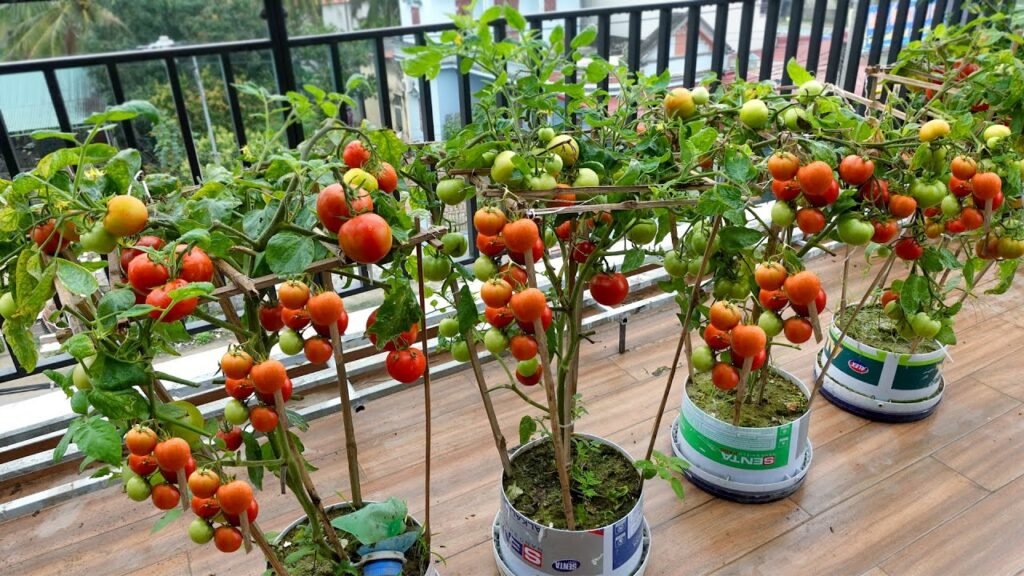
Vertical gardening offers several advantages over traditional gardening:
- Space Efficiency: Ideal for balconies, patios, and small yards.
- Higher Yield: Growing upwards allows more plants in less area.
- Improved Air Circulation: Reduces risk of fungal diseases.
- Easier Harvesting: Tomatoes hang at eye level or above, making picking simple.
- Better Sunlight Exposure: Upright growth ensures leaves get more light.
By growing tomatoes vertically, you can enjoy a bountiful harvest without needing a large garden.
Step 1: Choosing the Right Tomato Variety
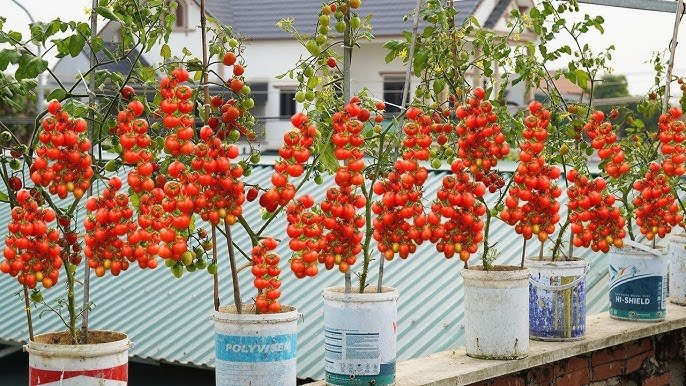
Not all tomatoes are suited for vertical gardening. Here’s how to pick the best variety:
- Indeterminate Varieties: These grow continuously and produce fruit throughout the season. Examples: Cherry tomatoes, Roma, Beefsteak.
- Determinant Varieties: Compact and bushy, suitable for small vertical setups. Examples: Patio, Tiny Tim.
- Consider Growth Habit: Indeterminate varieties benefit most from vertical support.
Choosing the right tomato variety ensures maximum yield and easier maintenance.
Step 2: Selecting a Vertical Garden Structure
Your vertical garden needs a strong, stable support system for tomato plants:
- Trellises: Simple wooden or metal structures. Ideal for small to medium plants.
- Tomato Cages: Cylinder-shaped cages provide support from all sides.
- Hanging Bags or Vertical Towers: Great for small spaces, using pots stacked vertically.
- DIY Options: PVC pipes, wooden pallets, or recycled materials can be repurposed into vertical supports.
A sturdy structure prevents plants from falling over and allows easy training of vines upward.
Step 3: Preparing Containers and Soil
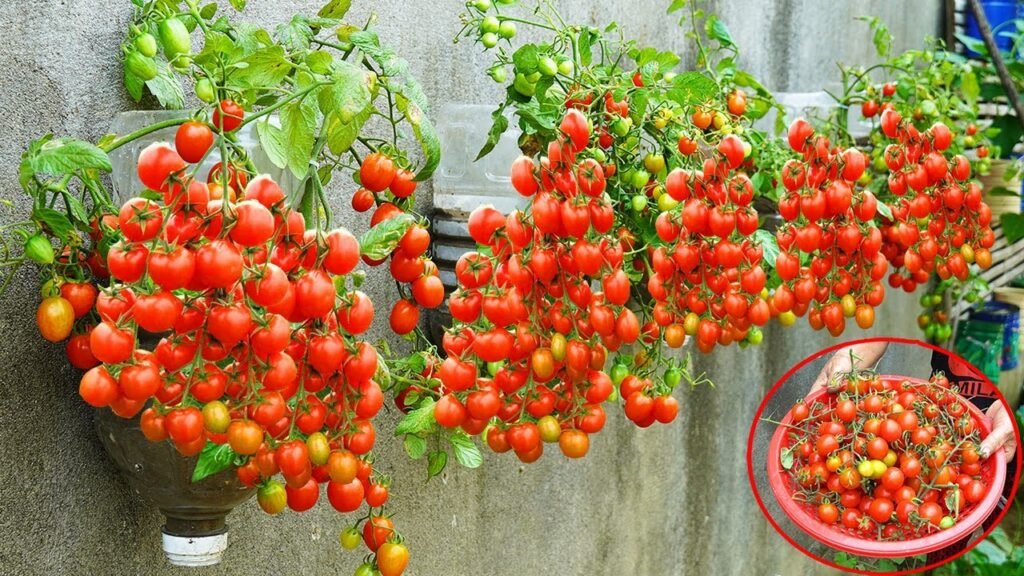
Healthy tomatoes start with the right soil and container:
- Container Size: At least 12–16 inches deep for medium varieties; larger for beefsteak tomatoes.
- Drainage: Ensure holes at the bottom to prevent waterlogging.
- Soil Mix: Use nutrient-rich, well-draining soil. Mix compost, garden soil, and perlite for aeration.
- Fertilization: Add slow-release organic fertilizers or compost for healthy growth.
Good soil and containers provide strong roots, better nutrient uptake, and consistent growth.
Step 4: Planting Tomatoes in a Vertical Garden
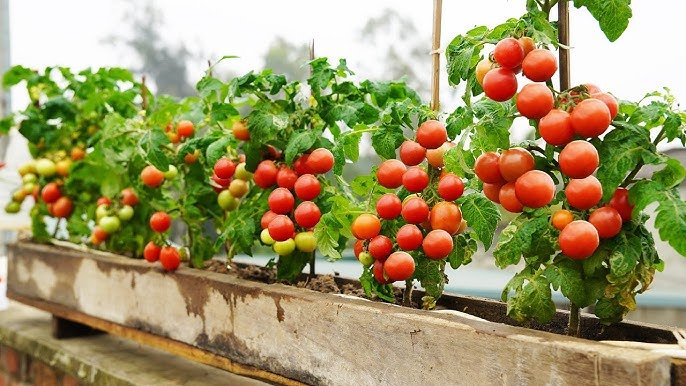
Planting is crucial for vertical success:
- Spacing: Leave 12–18 inches between plants to allow air circulation.
- Depth: Plant deep, burying part of the stem to encourage strong root development.
- Support: Insert a stake, trellis, or tie for vertical growth at planting time.
Proper planting ensures your tomatoes grow tall, healthy, and produce a high yield.
Step 5: Training and Pruning Tomato Plants
Training and pruning help your tomato plant grow efficiently:
- Tie the Main Stem: Use soft ties or twine to attach the stem to your vertical support.
- Remove Suckers: Pinch off side shoots between main stem and branches to focus energy on fruit production.
- Prune Lower Leaves: Prevent diseases by removing leaves that touch soil or crowd the base.
Regular pruning and training improve airflow, sunlight exposure, and fruit size.
Step 6: Watering and Fertilizing
Tomatoes require consistent water and nutrients:
- Watering: Keep soil moist but not waterlogged. Vertical setups dry out faster, so daily watering may be necessary.
- Mulching: Apply mulch around the base to retain moisture.
- Fertilizing: Feed plants with organic fertilizers high in potassium and phosphorus every 2–3 weeks.
- Foliar Spray: Optional nutrient sprays help promote flowering and fruiting.
Balanced watering and fertilization ensure healthy leaves, flowers, and abundant fruits.
Step 7: Managing Pests and Diseases
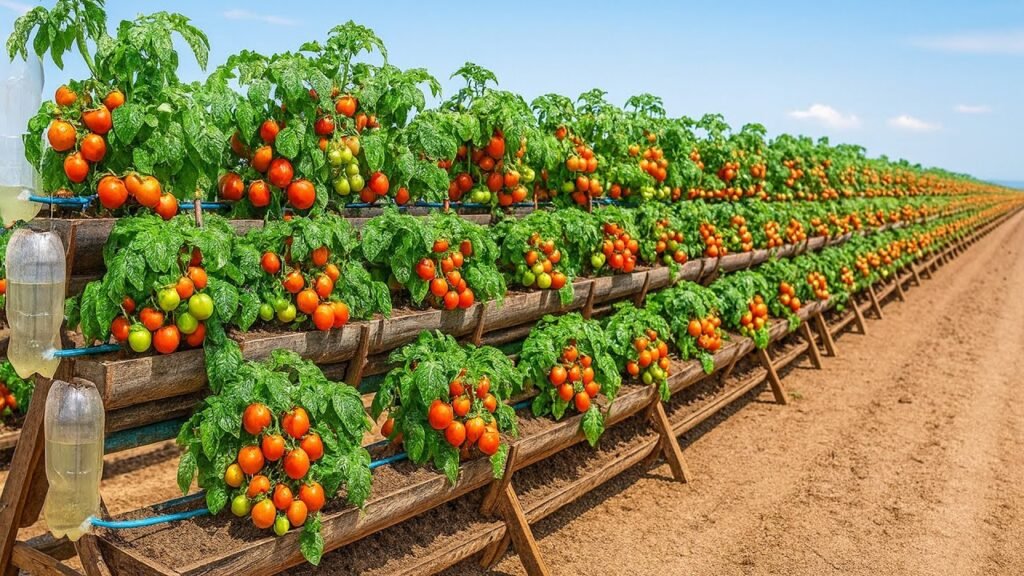
Tomatoes are prone to pests and diseases. Vertical gardening helps, but vigilance is necessary:
- Common Pests: Aphids, whiteflies, tomato hornworms. Use neem oil, insecticidal soap, or manual removal.
- Diseases: Fungal infections like blight or powdery mildew. Prune leaves for better airflow and avoid overhead watering.
- Companion Plants: Basil, marigold, and nasturtium repel pests naturally.
Healthy plants produce more fruits and reduce losses.
Step 8: Harvesting Tomatoes
One of the joys of vertical tomato gardening is easy harvesting:
- Ripeness: Harvest when tomatoes are fully colored and slightly soft to the touch.
- Regular Picking: Frequent harvesting encourages continuous fruit production.
- Storage: Store at room temperature or refrigerate for longer shelf life.
Vertical gardening makes it easier to access and harvest fruits without bending or reaching.
Tips for Maximizing Yield in a Vertical Tomato Garden
- Rotate Crops: Grow different tomato varieties to extend the harvest season.
- Use Fertilizer Wisely: Regular feeding boosts fruit size and flavor.
- Optimize Sunlight: Ensure plants get at least 6–8 hours of direct sunlight daily.
- Support Growth: Adjust ties and trellises as plants grow taller.
- Water Consistently: Vertical setups dry faster, so regular watering is crucial.
- Monitor Growth: Remove damaged leaves and check for pests regularly.
Following these tips ensures a bountiful harvest with minimal effort.
Benefits of Vertical Tomato Gardening
- Maximizes Space: Perfect for urban gardens and small patios.
- Reduces Disease: Better airflow prevents fungal infections.
- Easy Maintenance: Plants are easier to access for watering, pruning, and harvesting.
- Higher Yield: Vertical growth supports more plants per square foot.
- Aesthetic Appeal: Vertical gardens create a beautiful, green backdrop.
Vertical gardening transforms tomato cultivation into a productive and visually appealing experience.
Conclusion
Growing tomatoes in a vertical garden is a simple yet highly effective method to achieve a huge harvest. By choosing the right variety, preparing strong supports, planting properly, and maintaining plants with watering, pruning, and pest control, anyone can enjoy fresh, homegrown tomatoes year-round.
Whether you have a small balcony, backyard, or limited garden space, vertical tomato gardening maximizes yield, simplifies care, and ensures healthy plants. With patience and regular attention, your vertical garden will reward you with abundant, flavorful, and nutritious tomatoes, making every harvest a delight.
Vertical gardening isn’t just about space efficiency—it’s about growing smart, harvesting more, and enjoying the fruits of your labor with ease. Start your vertical tomato garden today and experience the joy of simple, massive, and rewarding harvests.
